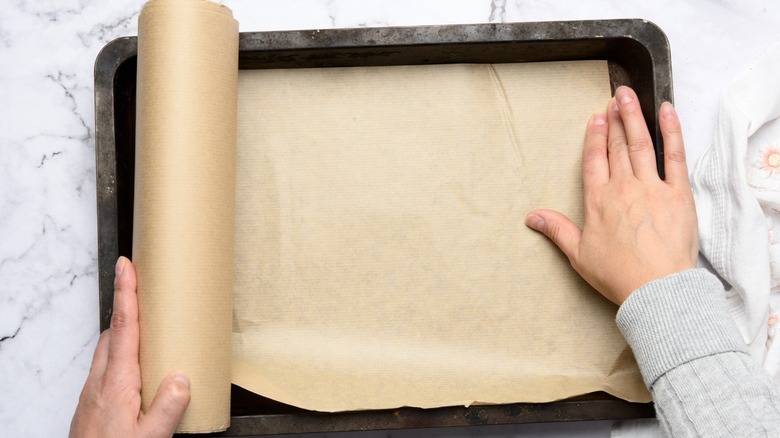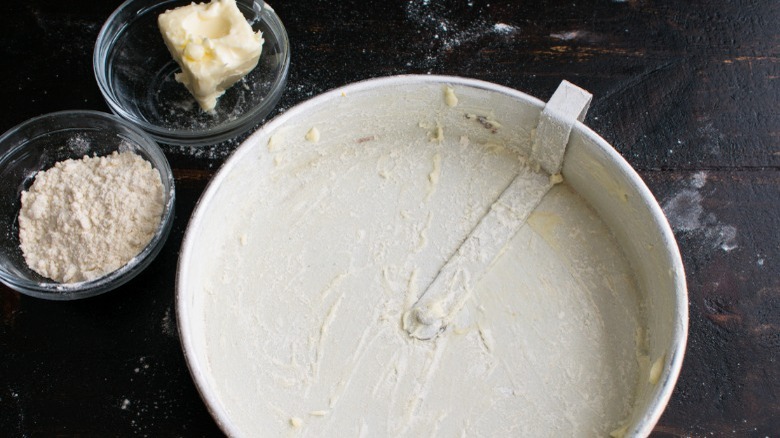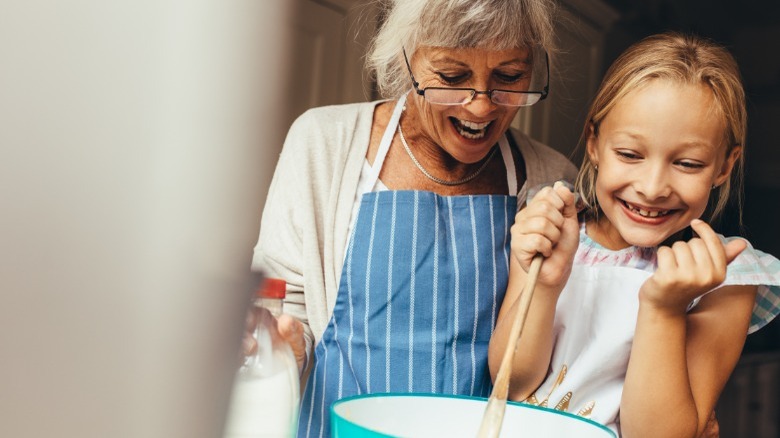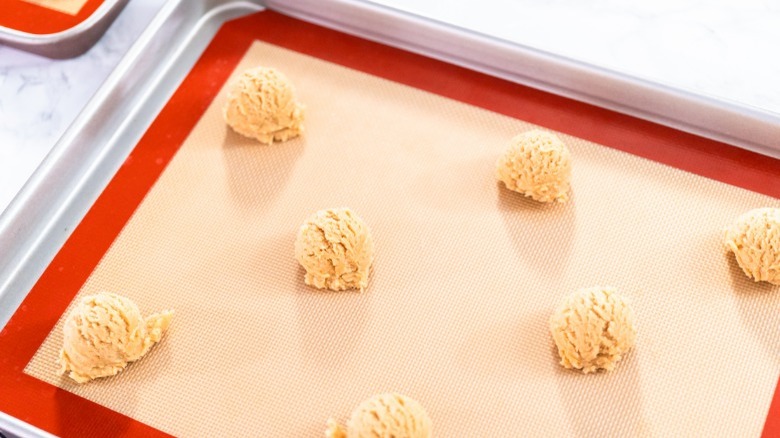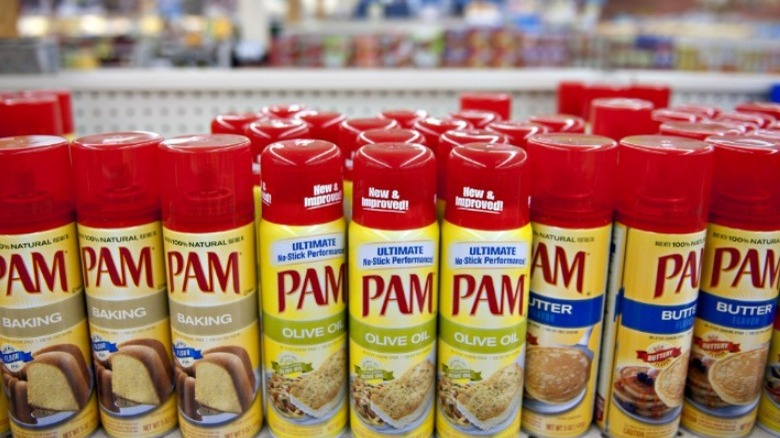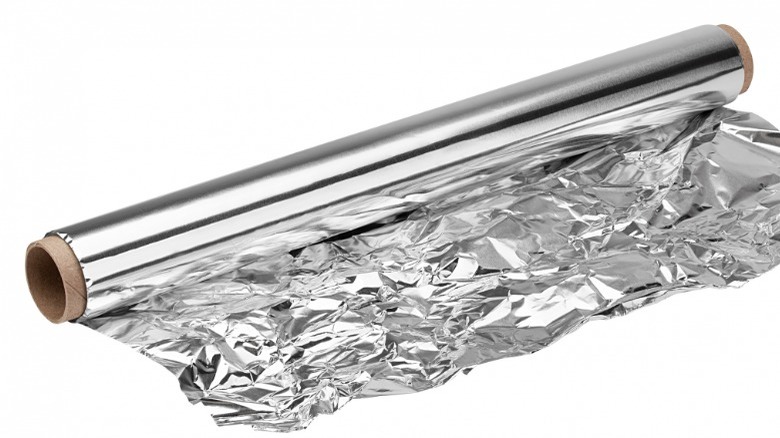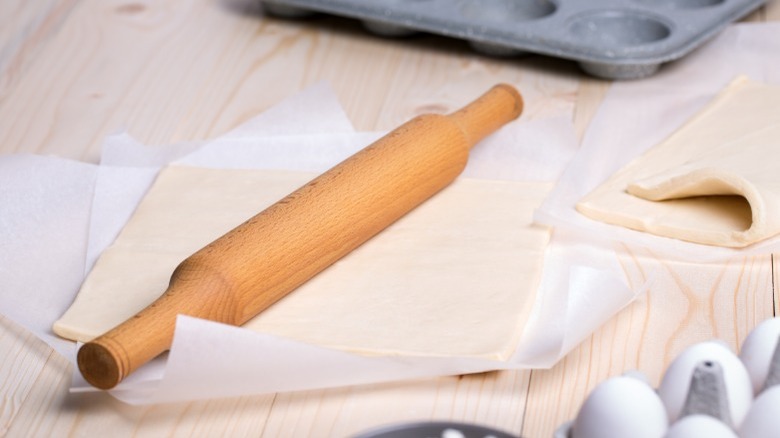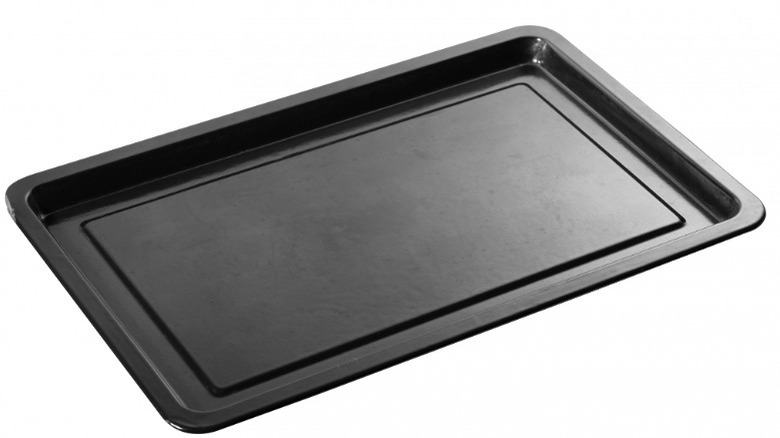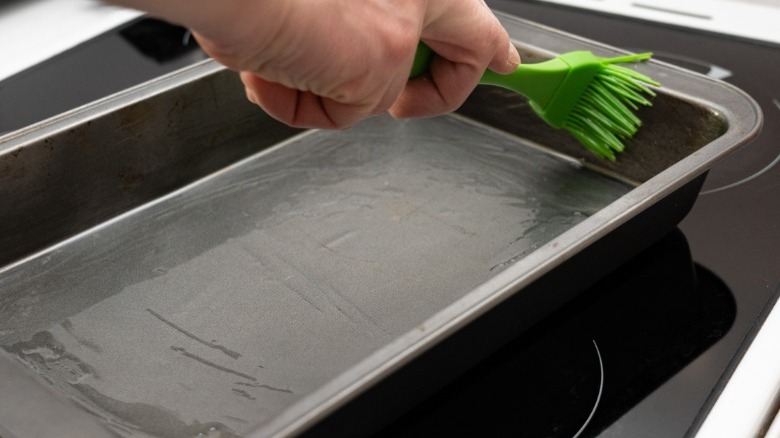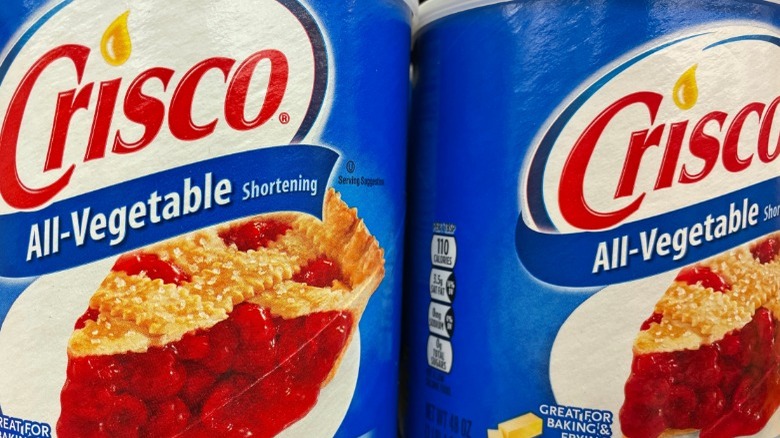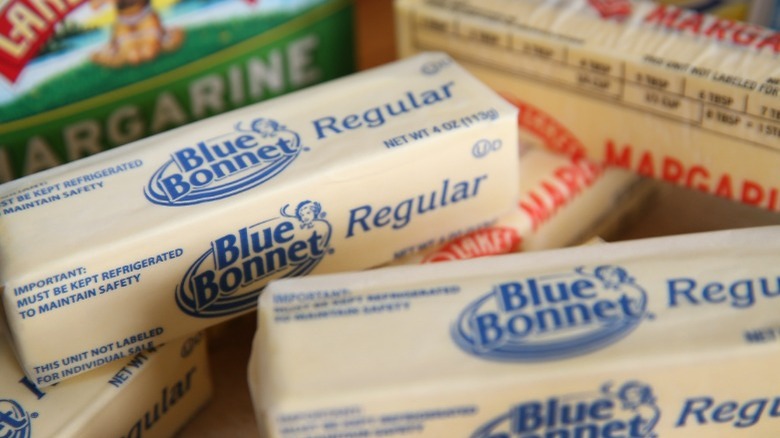10 Substitutes You Can Use In Place Of Parchment Paper
We may receive a commission on purchases made from links.
Parchment paper is different from wax paper, but it's incredibly handy to have in the kitchen. Made from cotton fibers and/or wood pulp, it's particularly helpful to use while baking, as it's nonstick and can stand temperatures as high as 428 degrees Fahrenheit.
That nonstick surface makes parchment paper good for other things besides baking, too. Reynolds says it can be used for covering surfaces when rolling out dough, and making parcels for cooking fish and vegetables. You can also put it on top of meats and chicken that need to be pounded thin, use it to protect countertops when making crafts, or use it to wrap cookies or flowers.
Some people might get frustrated using parchment paper as it keeps its rolled up shape, but there are two foolproof methods for getting parchment paper to lie flat: Crumple the torn-off sheet, or dampen your baking pan before using.
However, what about those times when you don't have parchment paper? Fortunately, there are lots of other ways to prevent food from sticking to pans. Here we explore 10 options, and best of all, you'll probably have most of them in your house already.
1. Butter and flour
Before there was parchment paper, bakers relied on butter and flour to prevent food from sticking. It can be a bit messier, but it works almost every time. Sometimes butter alone will suffice, but the flour adds an extra layer of assurance. From the Comfort of My Bowl says greasing and flouring can work really well if you don't have parchment to hand.
Land O Lakes explains that regular butter contains 80% butterfat, and greasing pans with it adds even more flavor to your creations. Put a dollop of butter onto a paper towel and completely coat the entire inside of your baking or cooking tin. You shouldn't need more than one tablespoon: Start with this and add more if needed. If you don't have butter, shortening works just as well, but doesn't have any flavor.
Once sufficiently greased, sprinkle a good amount of flour into the center of the pan. Working over your sink, shake the pan around, making sure the surfaces are completely covered. Tap out the excess and pour your batter in. The flour will also add a slight crispness to whatever you're baking.
2. Cake goop
The secret to greasing cake pans, this one has a funny name and works like a charm, as long as you don't pile it on too thickly. King Arthur Baking Company uses a pastry brush to apply cake goop to pans and recommends mixing up extra to keep in your pantry or refrigerator if you bake often. The basic cake goop recipe calls for equal measures of flour, vegetable oil, and shortening. But if you're making chocolate cake, feel free to swap out the flour for cocoa powder. Otherwise, you'll have white surfaces on the layers after they're baked.
Sugar Geek Show also likes cake goop and says you can use margarine if you don't have shortening. It advises against layering the mixture on too thickly, claiming it can actually cause sticking. Instead, apply a thin layer on the surfaces. It should be nice and even, and just thick enough to thoroughly cover the pan. You can do this right before you pour in the batter. You wouldn't want to use cake goop for cookies or other baked goods though, as it would make a real mess.
3. Silicone mats
Silicone mats are made from flexible, food-grade silicone and fiberglass, and are sold in different sizes to match baking pans. Like parchment paper, these little wonders make for easy cleanups. To use, WebstaurantStore Blog says these mats should be greased once they're placed on top of baking pans. They can also be heated up to 500 degrees Fahrenheit — giving silicone mats an edge over parchment paper — and are fine to put in the freezer. To clean, simply wash after each use with soap and water, and air dry.
A key benefit of using silicone mats is that they're reusable. The initial investment will cost more than buying a roll of parchment paper, but you don't need to toss them in the trash after.
There are some downsides to using silicone mats, though. Gygi posts that silicone mats are more slippery than parchment paper, so cookies might spread out more during baking. The bottoms of cookies can also become soggy when left to cool on silicone mats. To prevent that, wait for them to cool enough to transfer them onto racks. As silicone is an absorbent material, it can retain smells from previously baked and cooked foods. To stay on the safe side, have separate ones for cooking and baking. That is, unless you like fish-scented chocolate chip cookies.
4. Cooking spray
According to Cully's Kitchen, the truth about Pam nonstick cooking spray is that it contains oil and other ingredients in an aerosol. These work especially well to grease muffin pans and other small molds. These sprays contain extra ingredients like dimethylpolysiloxane, propane (or butane), and soy lecithin to make the oil spray more effectively. According to Food to Fit Nutrition, soy lecithin comes from soybeans, while dimethylpolysiloxane is an anti-foaming agent that can be used up to 10 parts per million in cooking sprays, and butane is used in very low concentrations.
Conagra Foodservice makes a Pam Baking Spray that contains flour, so this is an option if you normally coat your pans with fat and then shake on flour. It eliminates one step, and you don't have to use paper towels, which can get a bit messy. This particular spray is also tasteless, unlike cooking sprays that have butter or other flavorings. You can find baking sprays with flour made by other companies on Amazon.
5. Aluminum foil and cooking spray
Most kitchens have at least one roll of aluminum foil, but baked and cooked food will stick to it. Foil is good for lining pans for easy cleanups, but you'll need to add something on top if you don't want half of your cake to remain on it, such as butter, margarine, or cooking spray. CNET suggests not using aluminum foil for cooking and baking because it argues parchment paper is much better, but if you don't have any parchment paper, it can still be an acceptable option.
Aluminum foil sprayed with a nonstick cooking spray can work in a pinch, although research by the International Journal of Electrochemical Science suggests minimal amounts of aluminum foil can leach into food. Aluminum is also a heat conductor and this means that your food will cook faster. Be extra careful when baking cookies on foil, since they already don't take long to bake and may burn more easily.
6. Wax paper
It's easy to mix up wax paper and parchment paper because they have similar thicknesses, but they are quite different things that should be used for different purposes. Yummy.ph says that parchment paper is coated with silicone, but wax paper is coated with — you guessed it — wax. Never use wax paper to cook or bake food, because the wax will melt. If you've ever done this, you probably smelled smoke and ended up with wax in your food. Yuck.
Still, wax paper can be substituted for parchment paper some of the time. WebstaurantStore clarifies that wax paper is finished with paraffin wax, which is moisture-resistant. Use it instead of parchment paper to prevent sandwiches and other food from getting soggy. Wax paper also helps foods keep their crunch. It's also great for covering up dough that needs to be rolled out and for covering ice cream to prevent freezer burn. Wax paper is sold in sheets, bags, and regular rolls.
7. Nonstick pans
Even though the name suggests otherwise, people often end up greasing nonstick pans. Over time, the nonstick properties do lessen as it doesn't hold up particularly well to being heated up repeatedly (via Prudent Reviews). Nonstick pans need to be taken care of properly to maintain the surfaces, but if your sheet pan has got a little sticky over time, you might find yourself reverting to lining the pan with foil or parchment paper.
Consumer Reports advises against using cooking sprays on nonstick pans though, because they can ruin the surfaces. It claims the sprays leave films that are hard to remove, and build up over time. Livestrong suggests if you're using a dark, nonstick pan, heat the oven to 25 degrees Fahrenheit lower than the recipe suggests. Protect the pan with one of the other options suggested, and cook as usual.
Remember not to put your nonstick pan in the dishwasher, even if it's covered with grease. Williams Sonoma recommends letting the pan cool first, and strongly discourages the use of steel wool, harsh cleansers, and rough cleaning tools. Instead, use soft brushes, sponges, and gentle dishwashing liquid.
8. Oil
Cooking oils are useful for greasing pans when you don't have any parchment paper. The easiest way to do this is to pour a small amount of oil into the pan and spread it around with a pastry brush. Or, pour it onto a clean, dry paper towel and smear it onto the surface. For this, you'll want to use a neutral oil, so it won't affect the flavor of your food. Some options for neutral oils include canola, vegetable, grapeseed, sunflower, and avocado (via MasterClass). While you can use coconut oil and olive oil, you'll want to use refined versions as these have little flavor, and a higher smoke point in the case of olive oil.
Homesteading Family uses a DIY oil spray instead of the store-bought versions, and this is a good choice if you have concerns about the added ingredients used in commercial cooking sprays. With homemade oil sprays, you'll save money and use less. You'll need a good spray bottle, then simply add your favorite neutral oil in. If the spray nozzle clogs up, rinse or soak it in hot water.
9. Shortening
Shortening is a perfect parchment substitute. It's tasteless, so it won't do anything to change the flavor of your baked goods. It can add crispiness and keep cakes, cookies, and muffins softer for longer after baking. Crisco can also last for up to two years in your pantry. Crazy for Crust calls shortening foolproof, and uses paper towels to smear it on baking pans.
You may be wondering what shortening is and whether it's nutritious. Jotscroll says shortening is more than just Crisco: Any type of fat that solidifies at room temperature can be considered as shortening. While some shortening is vegan, others are made with animal fat (like lard), so do read the label to check. It's sold in sticks and tubs, and like butter, can be frozen. In case you're wondering, butter is not categorized as shortening because it contains water — it's 80% fat, and shortening is 100% fat.
Land O Lakes recommends using shortening for pie crusts, claiming the results are puffier and flakier when compared to butter. It might be missing that buttery flavor, but brands like Crisco make butter-flavored shortening, which does contain both natural and artificial flavors. This product should not be used as a spread though, and comes with the warning that it can catch fire if overheated.
10. Margarine
Some bakers might turn up their noses at the thought of baking with margarine. Blue Flame Kitchen explains margarine typically has less fat and more water than butter, which makes for a more bland taste.
However, if you want to use it to grease your pans, it can be a really great option as it won't impact the flavor, and will certainly do the job. To apply, use it in exactly the same way you would with butter or shortening, with or without flour. Take a small amount, rub it around your cake pans, make sure every surface is covered, and you're good to go.
According to Mayo Clinic, margarine is made from oils instead of milk or cream. Since the oils used don't contain a lot of saturated fats, they're a good option for heart-healthy eating. Still, some sold in other countries besides the U.S. can contain added trans fats. Read the labels to see how much fat they contain — and importantly, what kind of fat — and choose what's right for you. Bigger Bolder Baking adds that plant-based margarine is dairy-free and vegan, but is more processed than butter.
